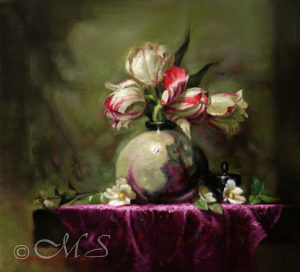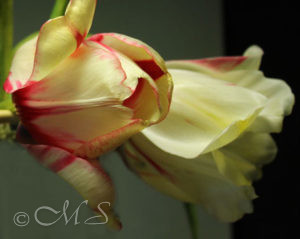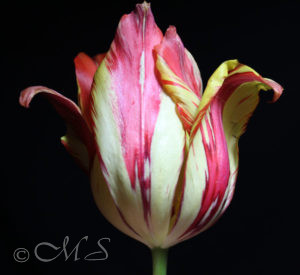
Copyright Margret E. Short 2019
When I first developed my Lessons from the Low Countries pigment project in 2006 / 07, I became completely in awe of the many glorious attributes of the tulip.
Since then, I have utilized this workhorse flower for many compositions. The reasons for this are simple: it is one of the most breathtakingly splendid flowers in the world and delightfully fun to paint! The varieties are endless, displaying all colors of the rainbow with ruffled, spiky, or smooth surfaces and coming in all sizes; tall, short, and in-between.
Origins of the Tulip
The collective understanding is, of course, that the tulip originated in Holland. This is not true at all. In fact, the flower did not appear on the Holland scene until the 16th century. Prior to that time, it was found all around the foothills and valleys of the Tien Shan Mountains where Tibet and China meet Russia and Afghanistan. Many legends and stories of the tulip can be found in Mike Dash’s book, Tulipomania, as he describes the flower’s journey to Holland.
A Beautiful Pattern, a Strange Disease

It was in the zenith of Tulip Mania in the 16th and early 17th century Holland that many tulips mysteriously developed a “feathery” look to their petals, or showed striations (flames) of colors rather than their usual solid color. In her book The Tulip, Anna Pavord describes how flowers would change and emerge in the spring with a completely new color. These beautiful flowers commanded staggering prices, and growers became rich only to learn later that the flaming was caused by a virus which had been spread by aphids. This virus weakened the flower, which soon plummeted in value and fortunes were sadly lost.

The virus soon took on the idiosyncratic name of the “Joker in the Tulip Bed.” The pesky joker had jinxed the bulbs’ health and caused this disastrous undoing. It wasn’t until much later, in the 1880s, that scientists actually uncovered the true cause, those pesky aphids. Nonetheless, the beauty of the flamed tulip captured the hearts of connoisseurs, and a new healthier breed was eventually developed. The joker was an auspicious consequence for artists like me who cannot resist the beauty of the flamed flower as a composition centerpiece.
My Joker in the Tulip Bed
My latest Joker in the Tulip Bed, shown at the very top of this page, will be exhibited in the Oil Painters of America 2019 Western Regional Juried Exhibit in Santa Fe, NM at the Sorrel Sky Gallery throughout November. If you are in the Santa Fe area, please come by and say hello!

Oh, the shimmer, the shine, the shadows, the beautiful rich raspberry color of the cloth on the table!! You are truly a wizard with oils and brushes and canvas! I’m sure the cloth is velvet. I can almost feel the texture. I love the tulips, too.
Thanks, Diane, for your observations and comments on the Joker. I purchased the raspberry scarf at a flea market in Mesa several years ago, and actually bought various colors of the same design, all a velvety texture. I have painted all of them at one time or another and love this color the best.
Nice
Thanks, Annie!
Margret
Beautiful. So interesting. Thanks for sharing.
Congratulations for being included in the Oil Painters of 2019.
Hello Arletha, The Oil Painters of America Western Regional was wonderful, and meeting artists from many states is always the highlight. See you soon.
Wonderful, Margret. Love this artwork, you really captured these tulips and the beautiful quality, as if they are real, and the history is great.
I Love tulips and was at the Keukenhof in Amsterdam and go to our local tulip farm every year.
Hope to see you soon.
Kay
Hi Kay, So glad you like the Joker and the history too. In my mind, it is one of the most fascinating eras in Dutch culture. We visited the Keukenhof gardens many years ago just at the right tulip blooming time. The Wooden Shoe gardens are spectacular too. So lucky to have this one so close.
Margret, It is always a delight to follow your research as well as your paintings. I wish I could get over there more often to see your work live, but the Blogs are a blessing.
Love, Gerald and Sandra
Hi Gerald and Sandra, I wish you could get over here more often too! Guess we’ll just have to communicate via blog till then. All the best to both of you.